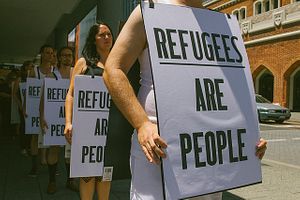On Tuesday the Papua New Guinea (PNG) Supreme Court ruled that the Manus Island detention center — one of two offshore facilities run by Canberra to hold those seeking asylum in Australia — is unconstitutional. The court ruled that the detention center breached a person’s right to personal liberty as enshrined in the PNG Constitution.
Section 42 of the PNG constitution simply states that “no person shall be deprived of his personal liberty,” except in reasonably justifiable cases like a criminal conviction.
A constitutional amendment was passed by the PNG parliament in 2014 to cover Section 42 from any potential legal difficulties with the Manus Island detention center. However, the court said it failed to properly explain why the detention center is “reasonably justifiable in a democratic society having a proper respect for the rights and dignity of mankind.”
Therefore, the PNG Supreme Court had no option but to rule that the Manus Island detention center “is unconstitutional and thus invalid with no force and effect.”
Justice Ambeng Kandakasi said, “Treating those required to remain in the relocation center as prisoners, irrespective of their circumstances or their status save only as asylum seekers, is to offend against their rights and freedoms as guaranteed by the various conventions on human rights at international law and under the PNG constitution.”
He added,“Their destination was and continues to be Australia; they did not enter PNG and do not remain in PNG on their own accord.”
After the Supreme Court ruling, the PNG’s prime minister, Peter O’Neill, confirmed that the detention center will be closed.
Presently, there are 850 men being held in Manus Island detention center, and around half of these people have had their refugee claims accepted.
The Manus Island detention center, along with a second detention center on Nauru, remain central components to Australia’s so-called “Pacific Solution” to those seeking to arrive in Australia via sea and claim political asylum.
Since the early-2000s, the Australian government’s policy has been to intercept all sea vessels containing irregular migrants and transport these people to either Manus Island or Nauru to have their claims of political asylum processed.
In 2013 the policy added a further component that all “unauthorized maritime arrivals” would have no chance of being resettled in Australia, regardless of whether or not they were deemed genuine refugees. The Australian government’s plan was to resettle those with refugee status to a third country. However, this has proved difficult to implement.
In September 2014 a deal was struck with Cambodia to resettle refugees. Yet, this scheme has proven unsuccessful, with Australia having so far paid $40 million in aid to Cambodia, and $15 million in costs, while only two refugees have been permanently resettled to date (five were moved to Cambodia, but only two remain there).
This decision for PNG to close the Manus Island detention center puts pressure on Australia to develop a new solution.
While O’Neill has stated that refugees are welcome to stay in PNG, it is unlikely that this would be considered a suitable arrangement. PNG lacks the resources to integrate refugees into the wider community, and with many areas of the country deemed highly dangerous and even lawless, refugees may not be safe.
It is possible that these 850 men could be transferred to Australia’s other detention center on Nauru. Yet the Nauru detention facility may not be equipped to handle the added number of asylum seekers. The facility there remains under heavy scrutiny from NGOs for its poor conditions. A number of doctors have spoken out about what they have witnessed while working there.
On Wednesday, an Iranian man, who remained on Nauru despite the fact his refugee status had been accepted, set himself on fire in protest at the conditions and continued detention.
The Australian government continues to state that the hardline procedures involved in the Pacific Solution are necessary to both stop people smugglers preying on asylum seekers and to prevent people from dying at sea while attempting to reach Australia.
It is correct that these two problems have been solved for the Australian government, with vessels no longer attempting to reach Australia. However, these are not solutions for people seeking asylum.
These policies seem to indicate that the Australian government is willing to create an environment more hostile than the environments asylum seekers are fleeing in order to reduce the incentive to seek asylum in Australia. It remains a policy driven by domestic electoral concerns, which outsources a large amount of Australia’s responsibility to the countries of PNG and Nauru.
The Pacific Solution has forced both PNG and Nauru to relinquish significant sovereignty to Australia in exchange for increased financial aid while housing detention facilities.
Despite being heavily reliant on Australian aid, this decision by the PNG Supreme Court regains some sovereignty for PNG. However, Nauru is almost entirely reliant on its detention center for income, making a similar ruling about the legality of its detention center highly unlikely.

































